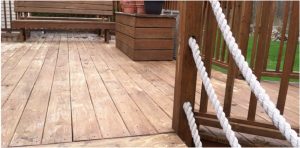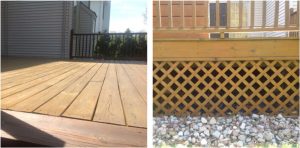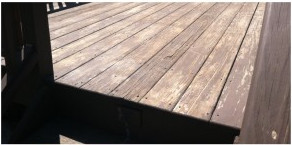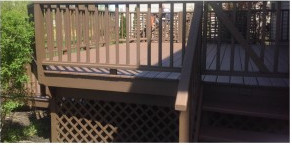It’s springtime in Ohio. For many of you, it’s that time of year to do some deck maintenance. After taking a beating of temperature changes and freeze/thaw cycles over the winter, your deck may not look as nice as it did last summer and fall. Many wonder, which type of stain is the best? Water-based or oil-based? Solid color or semi-transparent? There is no sure-fire answer, as there are pros and cons to all types of stains.
First and foremost, evaluate which type of stain, if any, is currently on your deck. For compatibility and color consistency, many people choose to stick with the same type of stain when re-coating. If you have a solid-color stain currently on your deck, it would not make much sense to put a semi-transparent stain over top of it. If you have a semi-transparent stain on your deck now, you have the option to stay with a semi-transparent or topcoat it with a solid color.
Here is a quick breakdown of the pros and cons of the different deck stains available.
- Water-Based Semi-Transparent Stains – since the stain is semi-transparent, you get the benefit of seeing the natural wood grain through the stain. Since these are water-based, you get the benefit of longer color retention. When compared to oil-based semi-transparent stains, the water-based counterparts tend to have a more milky appearance. In some cases, darker semi-transparent stains can appear solid after a couple of applications.
- Oil-Based Semi-Transparent Stains – like the water-based version, these stains allow the natural wood grain show through. Oil-based stains penetrate better than water-based formulas. The downside to oil-based formulas is that they fade much quicker than water-based versions. Many people prefer the look of the oil over the water. Due to EPA restrictions, most oil-based formulas are modified to meet V.O.C. regulations. These modified formulas tend to be higher in solids and take longer to dry. They are also a bit trickier to apply, as if they you apply too heavy or thick, they can remain tacky for a long period of time.
- Water-Based Solid Color Stains – Unlike semi-transparent stains, solid color stains completely cover the wood, much like a paint. These often are applied on decks that have accumulated numerous coats of stain over the years in order to give the deck a uniform appearance. Solid-color stains also provide a thicker film build which means it offers additional UV and weather protection.
- Oil-Based Solid Color Stains – These stains are very hard to come by due to recent EPA regulations. There are a few brands that still make a solid color or semi-solid oil stain. Like the others, oil-based stains will penetrate better into the wood but offer less color retention than water-based. This type of stain is not common.
Generally speaking, water-based deck stains have taken over in popularity over the recent years. Remember, the new stain that you put on your deck is only as good as the previous coats below it. Proper surface preparation is the key to allow your new stain to penetrate into the wood. If you are unsure in which route to go, have one of the experts at Pinpoint Painting come out and give you a free consultation on your deck!
Semi-Transparent Stain (Strongsville, OH)

Before

After
Solid Color Stain (Strongsville, OH)

Before

After
